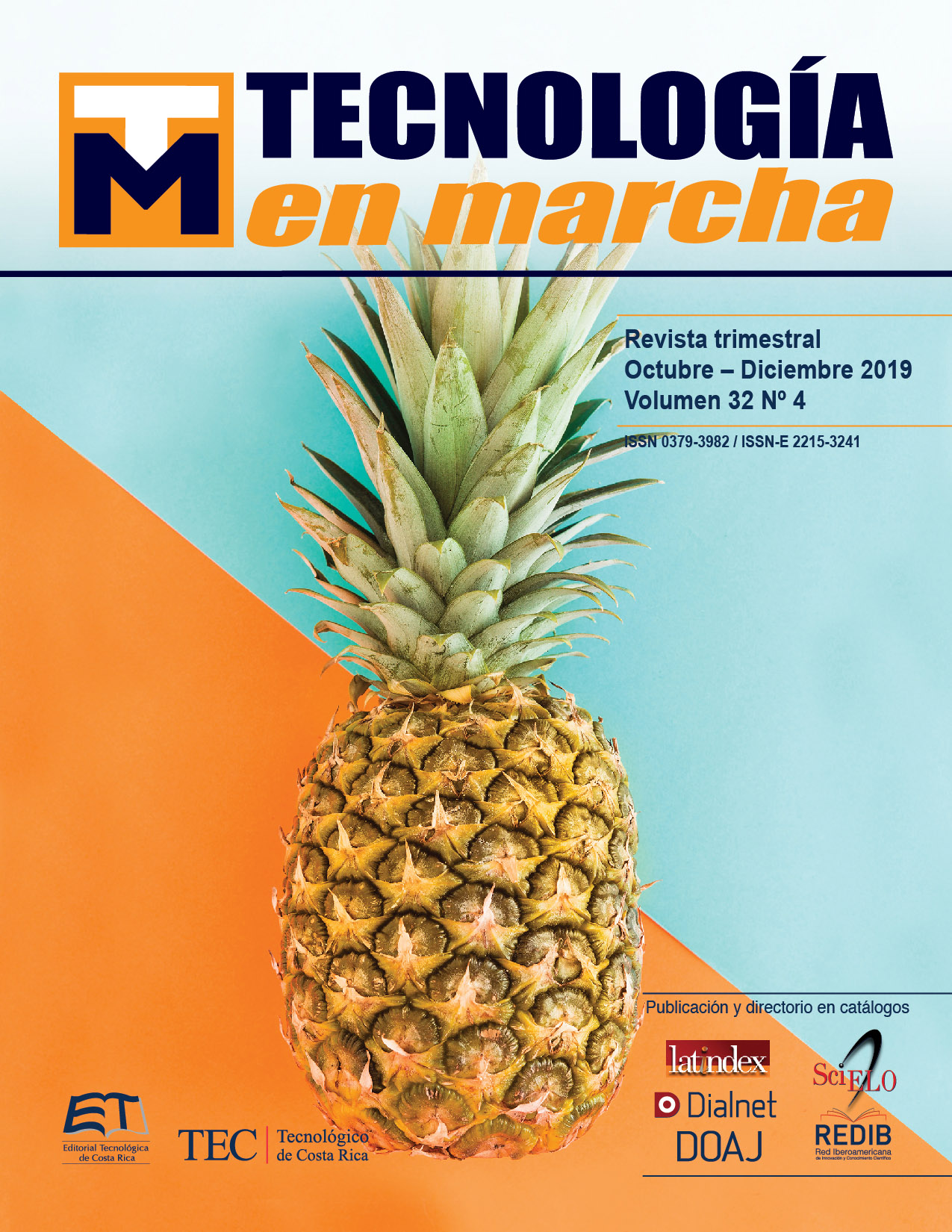Simulation of gasification of hydrocarbons-enriched biomass
Main Article Content
Abstract
Gasification is a thermochemical process in which organic raw materials are converted into gases containing H2 and CO (syngas), which can be used to obtain products such as electricity, fuels and other chemicals. It is influenced by characteristics of the system where the thermal conversion takes place, the operating conditions and the raw materials used. It was simulated a process of gasification of hydrocarbons-enriched biomass in which the gases generated are used for electricity generation, to evaluate the use of such raw materials. A non-stoichiometric gasification model, the Peng-Robinson equation of state as well as known gasification reactions were used. A downdraft gasifier was considered working with 22 kg/h of mix feed 3:1 biomass: hydrocarbons, 20 kg/h of air (gasifying agent), 1 atm of absolute pressure and gasification temperature of 900-1000 °C. The gases generated are composed of 27.44 % H2, 39.79 % CO, 5.73 % CH4, 0.1 % CO2 and 27.01 % N2. The net power of the gasifier is 27.82 kW and the consumption of the mixture 3:1 biomass:hydrocarbons 0.79 kg/kWh. The addition of hydrocarbons to biomass improves the characteristics of the syngas obtained and reduces the raw material requirements for the operation of the gasifier. The mixture 3:1 biomass:hydrocarbons is adequate for the performance of the process, allowing to take advantage of wastes that otherwise would have to be disposed of and treated, generating energy, environmental and economic benefits.
Article Details
Los autores conservan los derechos de autor y ceden a la revista el derecho de la primera publicación y pueda editarlo, reproducirlo, distribuirlo, exhibirlo y comunicarlo en el país y en el extranjero mediante medios impresos y electrónicos. Asimismo, asumen el compromiso sobre cualquier litigio o reclamación relacionada con derechos de propiedad intelectual, exonerando de responsabilidad a la Editorial Tecnológica de Costa Rica. Además, se establece que los autores pueden realizar otros acuerdos contractuales independientes y adicionales para la distribución no exclusiva de la versión del artículo publicado en esta revista (p. ej., incluirlo en un repositorio institucional o publicarlo en un libro) siempre que indiquen claramente que el trabajo se publicó por primera vez en esta revista.
References
[2] M. D. L. Pérez, Manual. Identificación de Residuos Industriales (UF0287). Certificados de Profesionalidad. Gestión de Residuos Urbanos e Industriales (SEAG0108). Editorial CEP, S.L., 2017.
[3] J. G. Speight, The Chemistry and Technology of Petroleum. Boca Raton: CRC press, 2014.
[4] F. Ramírez, E. Carazo, C. Roldán, and G. Villegas, “Encuesta de oferta y consumo energético nacional a partir de la biomasa en Costa Rica,” Dirección Sectorial de Energía, San José, 2007.
[5] E. C. Rada, Thermochemical Waste Treatment: Combustion, Gasification, and Other Methodologies. CRC Press, 2017.
[6] M. Verma, S. Godbout, S. K. Brar, O. Solomatnikova, S. P. Lemay, and J. P. Larouche, “Biofuels production from biomass by thermochemical conversion technologies,” International Journal of Chemical Engineering, vol. 2012, no. ID 542426, pp. 1-18, 2012.
[7] P. McKendry, “Energy production from biomass (part 3): gasification technologies,” Bioresource Technology, vol. 83, no. 1, pp. 55-63, 2002.
[8] P. Basu, Biomass Gasification and Pyrolysis: Practical Design and Theory. Academic press, 2010.
[9] A. Heraz Segura, “Estudio de gasificación mediante un prototipo experimental para el tratamiento termoquímico de residuos orgánicos,” Universidad Iberoamericana, 2012.
[10] A. Caballero-Chavarría, “Propuesta de un sistema de gasificación de residuos de hidrocarburos para aprovechamiento energético en el Plantel El Alto de RECOPE SA,” Escuela de Química, Instituto Tecnológico de Costa Rica, 2017.
[11] M. P. Rojas-Soto, “Estudio de pre-factibilidad de la transformación de residuos orgánicos municipales en energía,” Escuela de Química, Instituto Tecnológico de Costa Rica, 2017.
[12] M. M. Villalobos-Barquero, “Análisis de potencial de aprovechamiento energético de residuos de hidrocarburos por medio de gasificación en el Plantel El Alto de RECOPE SA,” Escuela de Química, Escuela de Química Instituto Tecnológico de Costa Rica, 2017.
[13] M. Puig-Arnavat, J. C. Bruno, and A. Coronas, “Review and analysis of biomass gasification models,” Renewable and Sustainable Energy Reviews, vol. 14, no. 9, pp. 2841-2851, 2010.
[14] B. Buragohain, P. Mahanta, and V. S. Moholkar, “Thermodynamic optimization of biomass gasification for decentralized power generation and Fischer–Tropsch synthesis,” Energy, vol. 35, no. 6, pp. 2557-2579, 2010.
[15] ALL Power Labs. (2015). Power Pallet - PP20. Available: http://www.allpowerlabs.com/wp-content/uploads/2015/10/PP20GeneratorOneSheet10_25_15Small.pdf
[16] Ley para la Gestión Integral de Residuos de la República de Costa Rica, Ley Nº 8839, 2010.
[17] M. J. Caselles Pomares, M. R. Gómez Antón, M. Molero Meneses, and J. Sardá Hoyo, Química Aplicada a la Ingeniería. Madrid: Universidad Nacional de Educación a Distancia, 2015.
[18] T. Pröll and H. Hofbauer, “H2 rich syngas by selective CO2 removal from biomass gasification in a dual fluidized bed system — Process modelling approach,” Fuel Processing Technology, vol. 89, no. 11, pp. 1207-1217, 2008.
[19] W. Doherty, A. Reynolds, and D. Kennedy, “Aspen plus simulation of biomass gasification in a steam blown dual fluidised bed,” in Materials and processes for energy: communicating current research and technological developments, A. Méndez-Vilas, Ed.: Formatex Research Centre, 2013.
[20] J. U. Castellanos, F. E. Sierra Vargas, C. A. Guerrero Fajardo, and L. F. Sosa Quintero, “Modelado del proceso de gasificación de biomasa para aprovechamiento energético: una revisión al estado del arte,” ITECKNE, vol. 9, no. 2, pp. 95-105, 2012.
[21] N. Couto, A. Rouboa, V. Silva, E. Monteiro, and K. Bouziane, “Influence of the biomass gasification processes on the final composition of syngas,” Energy Procedia, vol. 36, pp. 596-606, 2013.
[22] A. Z. Mendiburu, J. A. Carvalho, R. Zanzi, C. R. Coronado, and J. L. Silveira, “Thermochemical equilibrium modeling of a biomass downdraft gasifier: Constrained and unconstrained non-stoichiometric models,” Energy, vol. 71, pp. 624-637, 2014.
[23] B. Buragohain, P. Mahanta, and V. S. Moholkar, “Performance correlations for biomass gasifiers using semi-equilibrium non-stoichiometric thermodynamic models,” International Journal of Energy Research, vol. 36, pp. 590-618, 2012.
[24] T. K. Patra and P. N. Sheth, “Biomass gasification models for downdraft gasifier: A state-of-the-art review,” Renewable and Sustainable Energy Reviews, vol. 50, pp. 583-593, 2015.

